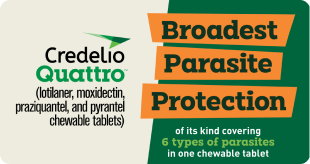Mirataz
Prescription required.
You already have a

subscription.
You already have a

subscription in cart.
Prescription required.
You already have a

subscription.
You already have a

subscription in cart.


What is Mirataz?
Mirataz is a transdermal (topical) medication for the management of weight loss in cats. In a clinical study, Mirataz resulted in significant weight gain in cats in as little as 14 days following topical application of 2 mg per day. Mirataz gives you a practical way to manage your cat’s weight loss without administration of oral medication and does not rely on your cat to eat to be medicated. Mirataz requires a prescription from your veterinarian.
For:
Cats (6 months of age or older, weighing 4.4 lbs or more)
Benefits:
- Manages weight loss in cats
- Apply topically to your cat’s ear
- No oral medication needed
- Does not rely on your cat to eat to be medicated
- Results in as little as 14 days
How does Mirataz work?
The exact mechanism by which mirtazapine induces weight gain has not been clearly elucidated but appears to be multifactorial.
Cautions:
In case of accidental skin exposure, wash thoroughly with soap and warm water. In case of accidental eye exposure, flush eyes with water. If skin or eye irritation occurs seek medical attention. In case of accidental ingestion, or if skin or eye irritation occurs, seek medical attention. Do not administer orally or to the eye. Use with caution in cats with hepatic disease. Mirtazapine may cause elevated serum liver enzymes. Use with caution in cats with kidney disease. Kidney disease may cause reduced clearance of mirtazapine which may result in higher drug exposure. The safe use of Mirataz has not been evaluated in cats that are intended for breeding, pregnant, or lactating cats.
Brand Name:
Mirataz
Generic Name:
mirtazapine transdermal ointment
What is the most important thing I should know about Mirataz?
Mirataz is indicated for the management of weight loss in cats. It requires a prescription from your veterinarian. Use with caution in cats with hepatic or kidney disease. Mirataz is meant to be administered topically. Do not administer orally or to the eye. Do not use in cats weighing less than 4.4 lbs or younger than 6 months. Upon discontinuation of Mirataz, it is important to monitor the cat’s food intake. Food intake may lessen after discontinuation of mirtazapine transdermal ointment. If food intake diminishes dramatically (>75%) for several days, or if your cat stops eating for more than 48 hours, have your veterinarian reevaluate your cat.
What should I discuss with my veterinarian before giving Mirataz to my pet?
Let your veterinarian know if your cat has kidney disease, hepatic disease, is less than 6 months of age, is pregnant, lactating, or intended for breeding.
How should Mirataz be applied?
Mirataz is applied topically to the inside of your cat’s ear. The usual dose is a 1.5 inch line of ointment applied on a disposable glove then gently rubbed into your cat’s ear. Wear disposable gloves when handling or applying Mirataz to prevent accidental topical exposure. After application, dispose of used gloves and wash hands with soap and water. After application, care should be taken that people or other animals in the household do not come in contact with the treated cat for 2 hours because mirtazapine can be absorbed transdermally (skin) and orally.
What are the potential side effects of Mirataz?
The most common adverse reactions included application site reactions, behavioral abnormalities (vocalization and hyperactivity), and vomiting.
What happens if I miss giving a dose of Mirataz?
If a dose is missed, apply Mirataz the following day and resume daily dosing.
What happens if I overdose my pet on Mirataz?
If an overdose is suspected, contact your veterinarian immediately.
What should I avoid while giving Mirataz to my pet?
After application, care should be taken that people or other animals in the household do not come in contact with the treated cat for 2 hours because mirtazapine can be absorbed transdermally and orally.
What other drugs will affect Mirataz?
Mirataz should not be given in combination, or within 14 days before or after treatment with a monoamine oxidase inhibitor (MAOI) [e.g. selegiline hydrochloride (L-deprenyl), amitraz], as there may be an increased risk of serotonin syndrome.


Mirataz Directions:
- Wear disposable gloves. Twist cap on tube counterclockwise to open.
- Apply even pressure on tube and squeeze a 1.5-inch line of ointment onto your gloved finger using the measured line on the carton or in this package insert.
- Using your gloved finger, gently rub ribbon of ointment on inside pinna (outermost visible part of the ear) of your cat’s ear spreading it evenly over the surface.
- Dispose of used gloves after each application. If contact with your skin occurs wash thoroughly with soap and warm water.
Alternate the daily application of Mirataz between the left and right ears. Do not administer into the external ear canal.
Mirataz Dosage:
| Weight | Dosage |
|---|---|
| All weights | Apply a 1.5 inch line of ointment daily or as recommended by your veterinarian |
| Dogs | Do not use! |
|---|
| Horses | Do not use! |
|---|
Storage:
Keep out of reach of children and pets.


Mirataz Ingredients:
| Active Ingredient (per tube) | Amount |
|---|---|
| Mirtazapine | 100 mg |


 Swipe
Swipe











































